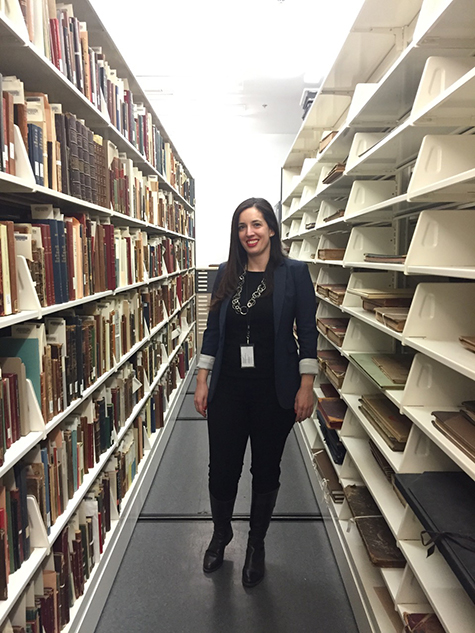 Noa Turel in the vault of the Dibner Library of the History of Science and Technology, Smithsonian Institution, Washington DC, where she pursued preliminary research for this project. Photo credit: Smithsonian InstitutionArt historian Noa Turel, Ph.D., of the University of Alabama at Birmingham, has been named a spring 2019 member of the Institute for Advanced Study. The Institute for Advanced Study is one of the world’s leading centers for curiosity-driven basic research. Since 1930, it has served as a model for protecting and promoting independent inquiry, prompting the establishment of similar institutes around the world, and underscoring the importance of academic freedom worldwide. Current philanthropic support and a reliable stream of endowment-generated revenue allow its permanent faculty and visiting researchers, known as members, to freely determine the course of their study.
Noa Turel in the vault of the Dibner Library of the History of Science and Technology, Smithsonian Institution, Washington DC, where she pursued preliminary research for this project. Photo credit: Smithsonian InstitutionArt historian Noa Turel, Ph.D., of the University of Alabama at Birmingham, has been named a spring 2019 member of the Institute for Advanced Study. The Institute for Advanced Study is one of the world’s leading centers for curiosity-driven basic research. Since 1930, it has served as a model for protecting and promoting independent inquiry, prompting the establishment of similar institutes around the world, and underscoring the importance of academic freedom worldwide. Current philanthropic support and a reliable stream of endowment-generated revenue allow its permanent faculty and visiting researchers, known as members, to freely determine the course of their study.
Turel is an assistant professor of art history in the College of Arts and Sciences’ Department of Art and Art History.
Each year, leading scientists and scholars from all over the world come to the institute to interact, explore, share and discover. A new intellectual mix of researchers and ideas is created, spanning young postdoctoral fellows to distinguished senior professors, across the humanities and sciences. The institute selects approximately 200 members from an average of more than 1,500 applicants annually. Members are selected by the faculty of each school, and come to the institute for periods as short as one term or as long as several years.
As a member, Turel is working on a project titled “Ingenious Secrets: Renaissance Painter-Engineers and the Rise of Technologized Europe.”
“Ingenious Secrets” is focused on the employment of painters as engineers in French and Italian Renaissance courts. Tracing the history of this vocational hybrid to the 15th century specifically, Turel shows how it helped effect a reversal in Europeans’ relationship with technology: from awe and suspicion to enthusiasm and appropriation. The book’s central working hypothesis is that this overlap of painting and engineering in Renaissance courts, a century-long fold in the history of art, was a crucial driver behind the emergence of Europe’s self-perception as a technological civilization.
“In the Middle Ages, advanced mechanical contraptions were associated with the Islamicate world, and they often evoked anxieties about demonic power as well as, more pragmatically, Western Christendom’s technological inferiority,” Turel wrote, in the project’s abstract. “Initially trading on the aura of machines as strange — in the dual sense of foreign and wondrous — early Renaissance visual iterations of the mechanical arts increasingly become, as I will show, exercises in de-mystification. In mechanical pageants and treatises on machines, Renaissance painters reflected to fellow Europeans a civilization with unprecedented and seemingly unbound power, thus facilitating the emergence of the age of global exploration and, eventually, hegemony.”
The institute’s mission and culture have produced an exceptional record of achievement. Among its faculty and members are 33 Nobel laureates, 42 of the 60 Fields medalists and 17 of the 19 Abel Prize laureates, as well as many MacArthur fellows and Wolf Prize winners. Past faculty have included Albert Einstein, one of its first professors who remained at the institute until his death in 1955, and distinguished scientists and scholars such as Kurt Gödel, J. Robert Oppenheimer, Erwin Panofsky, Hetty Goldman, Homer A. Thompson, John von Neumann, George Kennan, Hermann Weyl and Clifford Geertz.